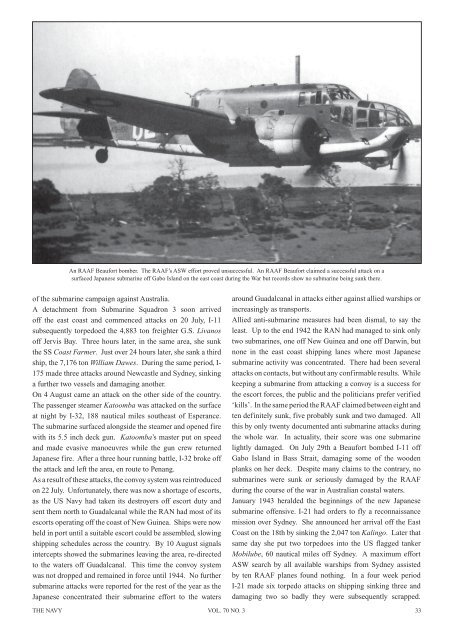The Navy Vol_70_No_4 Oct 2008 - Navy League of Australia
The Navy Vol_70_No_4 Oct 2008 - Navy League of Australia
The Navy Vol_70_No_4 Oct 2008 - Navy League of Australia
Create successful ePaper yourself
Turn your PDF publications into a flip-book with our unique Google optimized e-Paper software.
An RAAF Beaufort bomber. <strong>The</strong> RAAF’s ASW effort proved unsuccessful. An RAAF Beaufort claimed a successful attack on a<br />
surfaced Japanese submarine <strong>of</strong>f Gabo Island on the east coast during the War but records show no submarine being sunk there.<br />
<strong>of</strong> the submarine campaign against <strong>Australia</strong>.<br />
A detachment from Submarine Squadron 3 soon arrived<br />
<strong>of</strong>f the east coast and commenced attacks on 20 July, I-11<br />
subsequently torpedoed the 4,883 ton freighter G.S. Livanos<br />
<strong>of</strong>f Jervis Bay. Three hours later, in the same area, she sunk<br />
the SS Coast Farmer. Just over 24 hours later, she sank a third<br />
ship, the 7,176 ton William Dawes. During the same period, I-<br />
175 made three attacks around Newcastle and Sydney, sinking<br />
a further two vessels and damaging another.<br />
On 4 August came an attack on the other side <strong>of</strong> the country.<br />
<strong>The</strong> passenger steamer Katoomba was attacked on the surface<br />
at night by I-32, 188 nautical miles southeast <strong>of</strong> Esperance.<br />
<strong>The</strong> submarine surfaced alongside the steamer and opened fire<br />
with its 5.5 inch deck gun. Katoomba’s master put on speed<br />
and made evasive manoeuvres while the gun crew returned<br />
Japanese fire. After a three hour running battle, I-32 broke <strong>of</strong>f<br />
the attack and left the area, en route to Penang.<br />
As a result <strong>of</strong> these attacks, the convoy system was reintroduced<br />
on 22 July. Unfortunately, there was now a shortage <strong>of</strong> escorts,<br />
as the US <strong>Navy</strong> had taken its destroyers <strong>of</strong>f escort duty and<br />
sent them north to Guadalcanal while the RAN had most <strong>of</strong> its<br />
escorts operating <strong>of</strong>f the coast <strong>of</strong> New Guinea. Ships were now<br />
held in port until a suitable escort could be assembled, slowing<br />
shipping schedules across the country. By 10 August signals<br />
intercepts showed the submarines leaving the area, re-directed<br />
to the waters <strong>of</strong>f Guadalcanal. This time the convoy system<br />
was not dropped and remained in force until 1944. <strong>No</strong> further<br />
submarine attacks were reported for the rest <strong>of</strong> the year as the<br />
Japanese concentrated their submarine effort to the waters<br />
around Guadalcanal in attacks either against allied warships or<br />
increasingly as transports.<br />
Allied anti-submarine measures had been dismal, to say the<br />
least. Up to the end 1942 the RAN had managed to sink only<br />
two submarines, one <strong>of</strong>f New Guinea and one <strong>of</strong>f Darwin, but<br />
none in the east coast shipping lanes where most Japanese<br />
submarine activity was concentrated. <strong>The</strong>re had been several<br />
attacks on contacts, but without any confirmable results. While<br />
keeping a submarine from attacking a convoy is a success for<br />
the escort forces, the public and the politicians prefer verified<br />
‘kills’. In the same period the RAAF claimed between eight and<br />
ten definitely sunk, five probably sunk and two damaged. All<br />
this by only twenty documented anti submarine attacks during<br />
the whole war. In actuality, their score was one submarine<br />
lightly damaged. On July 29th a Beaufort bombed I-11 <strong>of</strong>f<br />
Gabo Island in Bass Strait, damaging some <strong>of</strong> the wooden<br />
planks on her deck. Despite many claims to the contrary, no<br />
submarines were sunk or seriously damaged by the RAAF<br />
during the course <strong>of</strong> the war in <strong>Australia</strong>n coastal waters.<br />
January 1943 heralded the beginnings <strong>of</strong> the new Japanese<br />
submarine <strong>of</strong>fensive. I-21 had orders to fly a reconnaissance<br />
mission over Sydney. She announced her arrival <strong>of</strong>f the East<br />
Coast on the 18th by sinking the 2,047 ton Kalingo. Later that<br />
same day she put two torpedoes into the US flagged tanker<br />
Mobilube, 60 nautical miles <strong>of</strong>f Sydney. A maximum effort<br />
ASW search by all available warships from Sydney assisted<br />
by ten RAAF planes found nothing. In a four week period<br />
I-21 made six torpedo attacks on shipping sinking three and<br />
damaging two so badly they were subsequently scrapped.<br />
THE NAVY VOL. <strong>70</strong> NO. 3 33

















